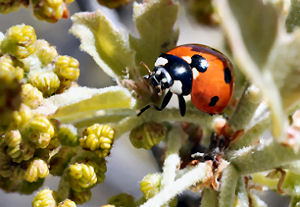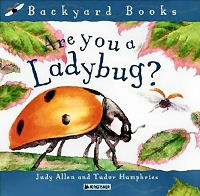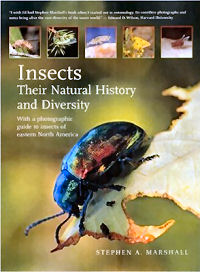
HOME
INTRO
SYMBOLS
ALMANAC
ECONOMY
GEOGRAPHY
STATE MAPS
PEOPLE
FORUM
NEWS
COOL SCHOOLS
STATE QUIZ
STATE LINKS
BOOK STORE
MARKETPLACE
NETSTATE.STORE
NETSTATE.MALL
GUESTBOOK
CONTACT US

New York State Insect: Ladybug
Photograph: National Park Service
Photographs, prints, and posters
New York Law
The following information was excerpted from the The Consolidated Laws of New York, STL - State, Article 6, Section 86.
STL - State
ARTICLE 6 - ARMS AND GREAT SEAL OF STATE
SECTION 86
§ 86. State insect. The lady bug (Coccinella novemnotata) shall be the official insect of the state of New York.
Sources...
The Consolidated Laws of New York. STL: Article 6-Section 86 Accessed January 11, 2011.
Shearer, Benjamin F. and Barbara S. State Names, Seals, Flags and Symbols: A Historical Guide Third Edition, Revised and Expanded. Westport, Conn: Greenwood Press, 3 Sub edition, 2001.
Additional Information
All About Ladybugs :
from Cornell's Lost Ladybug project.
:
from Cornell's Lost Ladybug project.

Lost Ladybug Project
Coccinella novemnotata, Nine Spotted Lady Beetle: Cornell University: Insect Conservation Biology - Threatened and Endangered Insects Abstracts.
The Lost Ladybug Project: Lost Ladybug Project, Comstock Hall, Cornell University, Ithaca, New York 14853.
Species Coccinella novemnotata - Nine-spotted Ladybeetle: BugGuide.net - Online community of naturalists who enjoy learning about and sharing our observations of insects, spiders, and other related creatures..
Coccinella novemnotata Herbst, 1793: Integrated Taxonomic Information System (ITIS) Here you will find authoritative taxonomic information on plants, animals, fungi, and microbes of North America and the world.
State Insects: Complete list of official state insects from NETSTATE.COM.
More symbols & emblems: Complete list of official New York state symbols.

Are You a Ladybug?
by Judy Allen, Tudor Humphries
Are You a Ladybug?, by Judy Allen, Tudor Humphries. 31 pages. Kingfisher (May 16, 2003) Reading level: Ages 4-8. Beginning with its title question, "Are you a ladybug?," this accessible book is perfect for reading aloud and tells young readers how they would experience life if they were a ladybug.
What About Ladybugs?, by Celia Godkin. 40 pages. Sierra Club Books for Children (April 26, 2001) Reading level: Ages 4-8. Accompanied by detailed, full-color illustrations, this simple story introduces young children to the important concept of nature's delicate balance. When a gardener sprays his plants with bug killer, he finds the results weren't what he expected. As his beautiful garden comes close to ruin, he begins to see that the plants and insects are linked.
Simon & Schuster Children's Guide to Insects and Spiders , by Jinny Johnson. 64 pages. Simon & Schuster Children's Publishing (May 1, 1997) Reading level: Ages 4-8. A detailed introduction to spiders and insects contains information about every major group of arachnids and insects, hundreds of thought-provoking facts, and full-color pictures and photographs."
Eyewitness Workbooks: Insect, 48 pages. DK CHILDREN; Workbook edition (June 16, 2008) Reading level: Ages 4-8. Perfect for getting ahead at school or just stimulating children's interest, this groundbreaking series of workbooks leaves the competition in the dust, with exciting subjects, 48 full-color pages, a turn-and-learn info wheel, and special carrying folders. This book helps kids take their knowledge of insects to the next level, from battling beetles to buzzing honeybees.

Garden Insects of North America
by Whitney Cranshaw
Garden Insects of North America: The Ultimate Guide to Backyard Bugs, by Whitney Cranshaw. 672 pages. Princeton University Press (March 8, 2004) Garden Insects of North America is the most comprehensive and user-friendly guide to the common insects and mites affecting yard and garden plants in North America. In a manner no previous book has come close to achieving, through full-color photos and concise, clear, scientifically accurate text, it describes the vast majority of species associated with shade trees and shrubs, turfgrass, flowers and ornamental plants, vegetables, and fruits--1,420 of them, including crickets, katydids, fruit flies, mealybugs, moths, maggots, borers, aphids, ants, bees, and many, many more.
Smithsonian Handbooks: Insects, by George C. McGavin. 256 pages. DK ADULT; 1st edition (October 1, 2002) Packed with over 650 crystal--clear photographs and illustrations with precise annotation to make identification sure and simple. Authoritative text, crystal--clear photography, and a systematic approach make this handbook the most comprehensive recognition guide to the insects, spiders, and other terrestrial arthropods of the world.

Insects by Stephen A. Marshall
Kaufman Field Guide to Insects of North America, by Eric R. Eaton, Kenn Kaufman. 392 pages. Houghton Mifflin Harcourt; 1 edition (February 28, 2007) In the new Kaufman Field Guide to Insects of North America, readers will find a wealth of information on the amazing observable behaviors of insects and their fascinating life histories. Naturalists Kenn Kaufman and Eric R. Eaton use a broad ecological approach rather than overly technical terms, making the book accessible and understandable for everyone. The guide is lavishly illustrated, with more than 2,350 digitally enhanced photographs representing every major group of insects found in North America north of Mexico.
National Wildlife Federation Field Guide to Insects and Spiders & Related Species of North America, by Arthur V. Evans. 496 pages. Sterling (May 31, 2007) National Wildlife Federation's new all-photographic field guide to North American insects, spiders, and related species, is the most up-to-date of its kind, and lets both amateur and expert naturalists identify more than 940 species quickly and accurately. More than 2,000 close-up color photographs by leading nature photographers reveal the field marks that distinguish each creature, and the clear and concise text that accompanies each image describes the range, habitat, life cycle, and behavior.
Insects: Their Natural History and Diversity, by Stephen A. Marshall. 736 pages. Firefly Books; Updated edition (June 2006) Meticulously researched and illustrated with color photographs, Insects is a landmark reference book that is ideal for any naturalist or entomologist. To enhance exact identification of insects, the photographs in this encyclopedic reference were taken in the field -- and are not pinned specimens.



